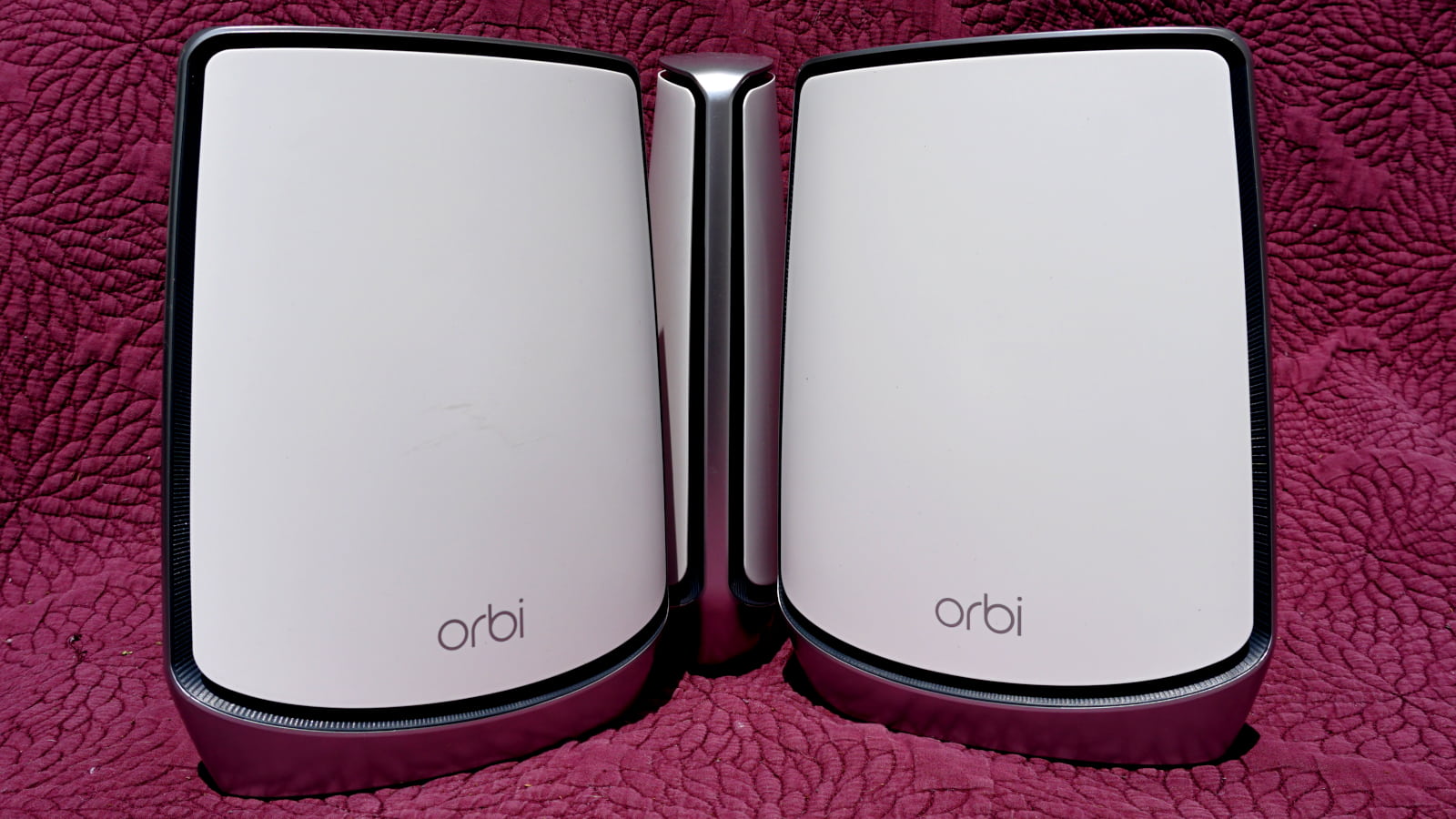How Important Is My Wireless Router to My Internet Speed?
May 24, 2023 | Share
Equipment Guides, FAQ, Internet Speed Guides
Your internet speed is limited by your plan. If your internet provider advertises 400Mbps, that’s the most you’ll ever see unless you upgrade to a faster plan.
However, your router handles everything on your side of the modem or ONT, so its performance can affect your wired and wireless connections.
We’ll explain what signs you should look for in a slow router, how older routers can affect your speed, and what you should do to improve your internet speed.
Why do I need a router?
You need a router so more than one device can access an internet connection. If that’s a good enough answer, move along to the next section—nothing else to read here, folks.
On a more technical level, data requires two addresses to complete a trip across the internet: A server address and a client address. Your internet provider assigns a public client address to the first wired device connected to your modem or ONT. The result is that only one of your devices—a computer, for example—can access the internet.
Now, imagine if we swap out the computer for a router. It receives the assigned public client address just like the computer. But it also has a built-in server that assigns new private client addresses to all your wired and wireless devices. Now any device connected to the router can send and receive data from the internet, not just a single computer.
In short, a router manages traffic to and from a modem or ONT.
Can a router slow my internet connection?
Technically, a router can’t slow your internet connection, but it can reduce the connection speeds between your devices and the modem or ONT. That bottleneck translates to a slow internet connection experience because the router is a slowpoke middleman between you and the internet.
An overwhelmed router can cause reduced speeds. It’s a tiny computer dedicated to routing network data, after all, so an overload can make the processor grow hot, causing it to work slower than usual.
Overload causes depend on the router and current network use. An old or low-quality router may produce slow speeds. Too many devices may upload and download data simultaneously, causing a network traffic jam. A faulty router causes slow speeds, too.
Another factor to consider is the type of Ethernet port. Pretend you have a 2,000Mbps (2Gbps) internet plan. Your modem or ONT has a multi-gig Ethernet port, which outputs internet speeds up to 2.5Gbps or faster to your router. But if your router only has Gigabit Ethernet ports, the most speed you can get is 1,000Mbps.
Overall, a router can be your chokepoint, not the internet connection itself. Upgrading to a plan with a higher bandwidth doesn’t help if your router can’t handle your current network load. You must reboot, reset, or swap it out for a better model.
How can I tell if I have a slow router or slow internet?
First, know your internet plan. Second, know how your router connects to your modem. As we suggested above, if you have a multi-gig plan and a multi-gig modem, you won’t see those speeds if your router supports only gigabit wired connections.
If everything checks out, run a wired internet speed test to see if your router is causing speed issues. Here’s how:
Step 1: Connect a computer to the router or gateway using an Ethernet cable.
Step 2: Open a web browser and load our speed test.
Step 3: Select Start Speed Test and record the results.
Step 4: Unplug the computer from the router.
Step 5: Unplug the router from your modem.
Step 6: Connect the computer to the modem using an Ethernet cable.
Step 7: Select Start Speed Test and record the results.
Step 8: Compare the results from the two tests (modems and ONTs only).
What if the modem test is faster than the router test?
Your router is your chokepoint. Remember, you ran these tests using a wired connection, so you should see most of the bandwidth delivered by your internet connection.
What if the modem test is the same as the router test?
If your router and modem’s wired speed test results aren’t dramatically different, then the next step is to test your wireless devices. Continue to the next section for instructions.
Run a Wi-Fi speed test
Step 1: Connect to the router’s 5 GHz or 6 GHz band.
Step 2: Download and install our speed test app (App Store, Google Play).
Step 3: Run the test two feet away from the router. Never test your Wi-Fi connection from 10 feet out or more.
Step 4: Compare the results to your wired test.
Is there a dramatic difference between your wired and wireless speeds?
If so, consult our guide on how to troubleshoot your Wi-Fi network. Chances are, you need to switch Wi-Fi channels, change the channel width, or disable a few settings—again, many factors can cause slow wireless speeds.
You can also consult our guide on speeding up your internet if your connections are slow.
Does outdated equipment affect my internet speed?
Older routers, network equipment, and even your aging wireless devices can affect your Wi-Fi speeds.
For example, if you have a plan that supports only 100Mbps, old routers and network equipment likely won’t bottleneck your connections. However, if you have a gigabit plan, but your old router supports only 100Mbps wired, your wireless connection will seem as slow as snails.
Old smartphones, tablets, and other devices can slow you down, too, even if you have the fastest router and internet plan on the planet. Newer devices with budget Wi-Fi radios can also make the internet feel extremely slow.
Check the device’s supported Wi-Fi standard
Technology and how we use it are constantly changing and improving—max Wi-Fi speeds have gone from 300Mbps in 2009 to 9.6Gbps in just ten years. And wired connections have jumped from 10Mbps to 40,000Mbps over the last few decades.
Wi-Fi standards are one primary reason why dated equipment might not perform as well as newer equipment. There are three main Wi-Fi standards to be aware of if you think your router or wireless device is causing slow wireless connections.
Wi-Fi 4 (802.11n or Wireless N)
This specification appeared in 2009 and uses one 2.4 GHz wireless band. It supports a theoretical maximum wireless speed of 150Mbps per spatial stream—up to 450Mbps in a three-transmit, three-receive stream configuration (3×3).
Wi-Fi 5 (802.11ac or Wireless AC)
This specification was finalized in 2014 and pairs the 2.4 GHz band (Wi-Fi 4) with an additional 5 GHz band for faster speed capabilities. The spec brought beamforming to Wi-Fi, which enables the router to time broadcasts through multiple antennas so Wi-Fi signals converge in specific locations. The Wave 2 variant introduced MU-MIMO technology for sending transmissions to more than one wireless device simultaneously.
Here are three Wi-Fi 5 configurations:
| Wave 1† | 802.11ac | Wave 2† | |
|---|---|---|---|
| Launch date | 2013 | 2014 | 2016 |
| Max throughput* | 1,300 | 6,900 | 3,470 |
| Max speed per stream* | 433 | 866 | 866 |
| Max stream config | 3×3 | 8×8 | 4×4 |
* in megabits per second
† approved by the Wi-Fi Alliance
Wi-Fi 6 (802.11ax or AX Wi-Fi)
This specification arrived in 2019 and upgraded both the 2.4 GHz and 5 GHz bands. It can reach max speeds up to a theoretical 9.6Gbps (9,600Mbps) using eight streams (8×8).
The primary goal of Wi-Fi 6 is to better handle network efficiency as opposed to just faster speeds. Many Wi-Fi 6 routers can easily handle dozens of connected devices, making them ideal for smart home devices.
Wi-Fi 6E (802.11axe or AXE Wi-Fi)
Released in 2020, Wi-Fi 6E is the most recent wireless standard, although some early Wi-Fi 7 routers appeared on the market in Q2 2023. Unlike Wi-Fi 6, the 6E version isn’t a major upgrade. It only adds support for the 6 GHz Wi-Fi band along with MU-MIMO technology for receiving transmissions from more than one wireless device simultaneously.
The bottom line
None of this is to say that all routers over a few years old are bad—Wi-Fi 5 routers can still be perfectly serviceable for some homes, and Wi-Fi 6 routers are commonplace in most homes.
But if you’ve upgraded your internet plan or added more devices to your network, an older router may have a harder time juggling the extra work than a newer model.
Can a new router speed up my internet?
A new router can’t increase your internet connection speed—your 300Mbps plan stays the same.
But a new router can make your Wi-Fi network run faster, especially if you’re upgrading from an outdated or faulty one. That 300Mbps plan can feel like a speed demon if your previous router didn’t fully utilize your plan’s bandwidth.
Keep in mind that a new router may not increase speeds on your wireless devices. If you purchase a Wi-Fi 6 router but still use a phone with Wi-Fi 5, your wireless connection won’t magically increase in speed. The phone still supports a theoretical max of only 866 Mbps, which is still higher than most cable-based internet plans.
Our verdict: routers can make or break a connection
A router doesn’t increase the speed of your internet connection. A 100Mbps plan remains as a 100Mbps plan, and there’s nothing you can do or add to increase your speed outside upgrading to a faster plan.
But a router can make or break the connections on your side of the modem or ONT. It’s the centerpiece of your home network, after all, so its performance is vital. An old or faulty router can make the internet feel like walking through mud. An incompatible or outdated router bottlenecks your speeds.
It’s important to keep your router in mind when you upgrade devices and internet plans. You can’t see the fastest speeds if you select a 1,200Mbps cable internet plan but your router supports only 1,000Mbps. The same is true with wireless devices: You don’t get the most speed when you connect the latest iPhone to that Wi-Fi 4 router you absolutely refuse to replace.
FAQ about wireless speeds
What is a theoretical maximum speed?
Theoretical means the radios used in access points and client devices are built to support a specific maximum speed. But you never see these speeds due to interference, range, and other factors.
What is a spatial stream and why does it matter?
A spatial stream is a single transmission of coded data sent or received through one antenna. Most wireless devices have two transmitting and two receiving antennas (2×2), which means they support two upload streams and two download streams. A 2×2 configuration doubles your speeds each way compared to devices with a 1×1 configuration. Some desktops support a faster 4×4 configuration.
Author - Rebecca Lee Armstrong
Rebecca Lee Armstrong has more than six years of experience writing about tech and the internet, with a specialty in hands-on testing. She started writing tech product and service reviews while finishing her BFA in creative writing at the University of Evansville and has found her niche writing about home networking, routers, and internet access at HighSpeedInternet.com. Her work has also been featured on Top Ten Reviews, MacSources, Windows Central, Android Central, Best Company, TechnoFAQ, and iMore.
Editor - Cara Haynes
Cara Haynes has been editing and writing in the digital space for seven years, and she's edited all things internet for HighSpeedInternet.com for five years. She graduated with a BA in English and a minor in editing from Brigham Young University. When she's not editing, she makes tech accessible through her freelance writing for brands like Pluralsight. She believes no one should feel lost in internet land and that a good internet connection significantly extends your life span.





